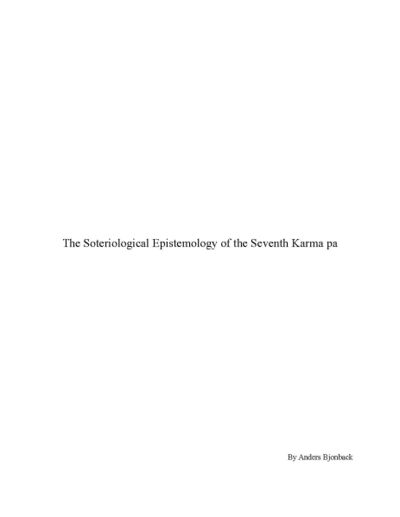No edit summary |
No edit summary |
||
| Line 22: | Line 22: | ||
*{{i|Part II: Rang rig in Pramāṅa and Mahāmudrā|97}} | *{{i|Part II: Rang rig in Pramāṅa and Mahāmudrā|97}} | ||
**{{i|2.1. Sūtra Mahāmudrā meditation|98}} | **{{i|2.1. Sūtra Mahāmudrā meditation|98}} | ||
**{{i|2.2. The Clear-Light Nature of Mind, The Buddha-Element, and Reflexive<br> Awareness: What One Experiences in Mahāmudrā|101}} | **{{i|2.2. The Clear-Light Nature of Mind, The Buddha-Element, and Reflexive<br> Awareness: What One Experiences in Mahāmudrā|101}} | ||
**{{i|2.3. The Seventh Karma pa’s Understanding of Mind’s Nature and Its Relevance to Mahāmudā|110}} | **{{i|2.3. The Seventh Karma pa’s Understanding of Mind’s Nature and Its Relevance to Mahāmudā|110}} | ||
**{{i|2.4. Using Rang-rig to Describe the Process of Meditation|132}} | **{{i|2.4. Using Rang-rig to Describe the Process of Meditation|132}} | ||
Revision as of 18:14, 12 August 2020
Abstract
Given the disregard many lamas and yogis have had towards the soteriological efficacy of epistemology, one may come to the false conclusion that epistemology is only relevant to the context of debate, without any application to meditation practice and the path to liberation. However, one can clearly see that this is not completely true, since Dharmakīrti (c. 600 CE), who is arguably Buddhism’s most influential epistemologist, provides an account of how a practitioner may attain the liberative cognition known as yogic direct valid means of cognition (rnal ’byor mngon sum tshad ma, hereafter referred to as yogic perception). In Tibet, the dGe lugs pa-s are particularly known for their soteriological use of epistemology, which is unsurprising given their emphasis on scholarship, but there are even thinkers in the meditation- oriented bKa’ brgyud school who have a soteriologically-oriented take on epistemology.
The aim in thesis is to show how bKa’ brgyud epistemologists’ (most notably, the Seventh Karma pa’s (1454-1506)) view on yogic perception differs from that of Dharmakīrti and the dGe lugs pa-s, since most western scholarship on Buddhist epistemology has focused on them. Like Dharmakīrti and the dGe lugs pa-s, the Seventh Karma pa describes the gradual path to attaining yogic perception through inference and familiarization, although there are striking differences in their understandings of the nature of what is observed in this type of perception. His epistemology is not only relevant to the scholarly path of inference, as one finds with most epistemologists, however. His view on reflexive awareness represents a common ground between the theory attached to Mahāmudrā, and pramāṇa, which allows for an epistemological explanation of the Mahāmudrā method of “taking direct perception as the path.” Through showing first, how his view of yogic perception differs from Dharmakīrti and the dGe lugs pa-s,and secondly, how his view concerning reflexive awareness is connected to Mahāmudrā, I wish to show the unique characteristics of the Seventh Karma pa’s brand of soteriological epistemology.
| Citation | Bjonback, Anders. "The Soteriological Epistemology of the Seventh Karma pa." MA thesis, Rangjung Yeshe Institute, 2013. |
|---|---|

